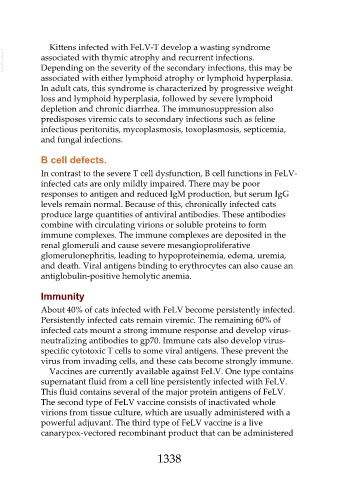Page 1338 - Veterinary Immunology, 10th Edition
P. 1338
Kittens infected with FeLV-T develop a wasting syndrome
VetBooks.ir associated with thymic atrophy and recurrent infections.
Depending on the severity of the secondary infections, this may be
associated with either lymphoid atrophy or lymphoid hyperplasia.
In adult cats, this syndrome is characterized by progressive weight
loss and lymphoid hyperplasia, followed by severe lymphoid
depletion and chronic diarrhea. The immunosuppression also
predisposes viremic cats to secondary infections such as feline
infectious peritonitis, mycoplasmosis, toxoplasmosis, septicemia,
and fungal infections.
B cell defects.
In contrast to the severe T cell dysfunction, B cell functions in FeLV-
infected cats are only mildly impaired. There may be poor
responses to antigen and reduced IgM production, but serum IgG
levels remain normal. Because of this, chronically infected cats
produce large quantities of antiviral antibodies. These antibodies
combine with circulating virions or soluble proteins to form
immune complexes. The immune complexes are deposited in the
renal glomeruli and cause severe mesangioproliferative
glomerulonephritis, leading to hypoproteinemia, edema, uremia,
and death. Viral antigens binding to erythrocytes can also cause an
antiglobulin-positive hemolytic anemia.
Immunity
About 40% of cats infected with FeLV become persistently infected.
Persistently infected cats remain viremic. The remaining 60% of
infected cats mount a strong immune response and develop virus-
neutralizing antibodies to gp70. Immune cats also develop virus-
specific cytotoxic T cells to some viral antigens. These prevent the
virus from invading cells, and these cats become strongly immune.
Vaccines are currently available against FeLV. One type contains
supernatant fluid from a cell line persistently infected with FeLV.
This fluid contains several of the major protein antigens of FeLV.
The second type of FeLV vaccine consists of inactivated whole
virions from tissue culture, which are usually administered with a
powerful adjuvant. The third type of FeLV vaccine is a live
canarypox-vectored recombinant product that can be administered
1338

